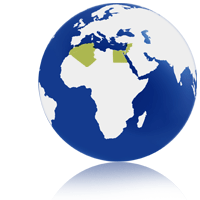North Africa and the Middle East
EUMEDCONNECT3
EUMEDCONNECT3 is a high-capacity IP-based data-communications network which provides international connectivity for the research and education community in the southern and eastern Mediterranean via EUMEDCONNECT3 and GÉANT hubs. The beneficiary countries of EUMEDCONNECT3 are Algeria, Morocco, Tunisia, Libya, Egypt, Palestine, Jordan, Lebanon and Syria. The links currently in place under EUMEDCONNECT3 are as follows:
| ARN |
Algeria |
connected at 622 Mbps |
| PalNREN |
Palestinian
Territories |
connected at 45 Mbps |
With its direct links to GÉANT, EUMEDCONNECT3 provides access to over 40 million users at over 8000 R&E establishments across Europe. Via GÉANT’s connections to other world regions, EUMEDCONNECT3 is a gateway for Mediterranean researchers to be truly global players..

Providing a R&E network for the Mediterranean since 2004
Running from 2011-2014, EUMEDCONNECT3 is co-funded with €3.3m by the European Union and is in its third phase. Through its earlier phases, the EUMEDCONNECT programme has connected Algeria, Egypt, Jordan, Morocco, Palestine, Syria and Tunisia since 2004, promoting regional development and addressing local challenges, such as telecom monopolies and poor infrastructure. In the current phase, connections are being re-established, initially with Algeria, Egypt and Palestine, with additional countries eligible for EC funding support.
EUMEDCONNECT3 forms the platform for the Arab States Research and Education Network (ASREN) which has been launched to create a R&E network for the wider Arab region, This is a strategic step that is expected to lead to long-term sustainability of e-Infrastructures in the Mediterranean and the neighbouring Gulf region, potentially serving a population of over 250 million people and ensuring that scientists and academics in the region can continue to participate in world-class research and education activities.
As Mediterranean neighbours, the NRENs of Cyprus, France, Greece, Italy and Spain are particularly interested in the collaboration opportunities offered by the programme and are active partners. EUMEDCONNECT3 is run by DANTE, in collaboration with ASREN, the European and local NRENs. To learn more, visit the EUMEDCONNECT3 website.
Connecting to Egypt
Through a 622-Mbps connection between Alexandria and Amsterdam, the Egyptian National S&T Information Network, ENSTINET, connects to GÉANT, providing connectivity for end users at Egypt's research institutions.
Connecting to Other Middle East Countries
United Arab Emirates
ANKABUT is the Research and Education Network for the United Arab Emirates. ANKABUT, which means spider in Arabic, interconnects federal universities in the UAE and provides for international connectivity with Research and Education Networking peers. Via an ANKABUT link to Internet2 in the United States, academics and researchers in Europe and the UAE are able to collaborate with one another.
Qatar
Established in 1995, the Qatar Foundation is a not-for-profit organisation which focuses on education, scientific research and community development in the state of Qatar. The Qatar Foundation’s flagship project is Education City, a 1,000-hectare campus on the edge of Doha where most of its member institutions are located. In a similar fashion to ANKABUT in the UAE, connectivity between the Qatar Foundation and GÉANT is provided indirectly.
Saudi Arabia
SARInet is the Saudi Arabian Research and Education Network which is formed by the King Abdullah University of Science and Technology (KAUST) and the King Abdulaziz City for Science and Technology (KACST). SARInet is administered and operated by KACST. A 1-Gbps link from SARInet to GÉANT has been implemented by KAUST and has been operational since early 2011.
|
 |